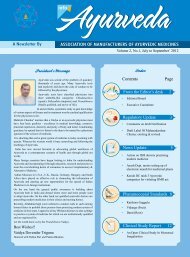Issue 12 - amam-ayurveda.org
Issue 12 - amam-ayurveda.org
Issue 12 - amam-ayurveda.org
Create successful ePaper yourself
Turn your PDF publications into a flip-book with our unique Google optimized e-Paper software.
Observational Clinical Study On Basant Kusumarkar Ras<br />
In Diabetes & Diabetic Neuropathy<br />
INVESTIGATORS:<br />
Dr. Ashok Kumar Jain,<br />
Head, Department of Ayurveda, Panchkarma & Yoga<br />
and<br />
Dr. T. K. Das,<br />
Chief Neurologist,<br />
at<br />
SVS Marwari Hospital, Kolkata<br />
1. INTRODUCTION:<br />
Diabetes mellitus – generally termed as Madhumeha in Ayurvedic<br />
terminology, is a frequent clinical problem. The incidence of Diabetes has<br />
been on a constant rise during last few decades more in particular, in the<br />
developing countries like India. Insulin is a hormone produced by β islets<br />
of Langerhan’s cells in pancreas and this hormone is implicated to play a<br />
vital role in the metabolism of carbohydrates and utilization of glucose.<br />
Diabetes is characterized by a defective synthesis of insulin.<br />
Based on the mode of onset and the extent of damage to the insulin<br />
producing cells, diabetes is clinically classified into two types. The first<br />
type is termed as insulin dependent Diabetes mellitus [IDDM] and other is<br />
termed as Non-Insulin Dependent Diabetes Mellitus [NIDDM]. Modern<br />
therapeutic approaches have been fairly successful to handle the primary<br />
sequel of the problem, the hyperglycaemia. In case of IDDM, direct<br />
administration of Insulin and in case of NIDDM, hypoglycaemic agents<br />
have been successfully employed.<br />
Notwithstanding these developments, there are two major areas of<br />
concern. The first one being the incidence and distribution of diabetes.<br />
Of an estimated 80 million of diabetics, over 50m. belong to heavily<br />
populated, developing countries like India. The incidence also leans<br />
primarily, towards urban population. About 1.5% of urban population<br />
is diabetics as against a 0.8% rural population. There are countries/<br />
communities with over 35% population being diabetics. Going by the<br />
upward trends in diabetic population the incidence appears to reach a<br />
phenomenally complex stage.<br />
The second important issue is the secondary sequel to diabetes. Many<br />
internal <strong>org</strong>ans are likely to be effected due to a paradoxical glucose<br />
metabolism. Of all the diabetic maladies, diabetic neuropathy affects<br />
almost 30% cases in maturity on-set diabetes. In fact, the on-set of diabetes<br />
is often manifested by early changes of neuropathy like, tingling sensations<br />
in soles and palms, muscular pain in lower extremities, claudication etc.<br />
Thus, neuropathy is essentially identified together with diabetes mellitus.<br />
Unfortunately, the sequel of diabetes is mostly irreversible and there<br />
appears no practical approach to address them.<br />
On the other hand, Ayurveda has laid down a range of therapeutic measure<br />
to address various issues linked to diabetes or madhumeha. Many studies<br />
were conducted on a number of herbs mentioned in Ayurvedic literature<br />
with an objective to develop natural hypoglycaemic agents. The success<br />
in this direction has been very little for, most of the herbs failed to reduce<br />
blood sugar levels in the desired manner. The altered approach of these<br />
investigations was found to more effective, where, an ayurvedic medicinal<br />
plant is used as an adjuvant therapy to overcome drug resistance in<br />
diabetes. However, the efficacy of Ayurvedic drugs or formulations in<br />
different complications of diabetes was sparingly reported.<br />
Basant Kusumakar Ras in Diabetes:<br />
Basant Kusumakar Ras is a generic Ayurvedic, herbo-mineral formulation<br />
info Ayurveda, Volume 1, No.<strong>12</strong>, April-June’ 20<strong>12</strong><br />
described in ancient Ayurvedic texts. As per Rasendrasar Sangraha,<br />
it contains Swarna Bhasma, Rajata Bhasma, Vanga Bhasma, Naga<br />
Bhasma, Kantaloha Bhasma, Abhraka Bhasma, Pravala Bhasma, and<br />
Mukta Bhasma. The blend is further processed in the extracts of 9 herbal<br />
ingredients and flavoured with Musk.<br />
Basant Kusumakar Ras is primarily, a Rasayana formulation but the<br />
text enumerates diabetes as one of its main therapeutic indication. The<br />
formulation is acclaimed to strengthen physiology as whole, to prevent<br />
loss of hair, premature graying of hair, to promote memory and fertility.<br />
Considering these descriptions, Ayurvedic physicians often recommend<br />
Basant Kusumakar Ras to improve/maintain the quality of life in diabetic<br />
patients. However, there have been no scientific reports to validate the<br />
acclaimed clinical usage of this formulation.<br />
Dabur Research centre have concluded experimental studies in<br />
collaboration with Department of Pharmacology, AIIMS – where Basant<br />
Kusumakar Ras was found to be having some improvement in blood sugar<br />
in Alloxan induced diabetic rats. This study thus succeeded to shed a little<br />
light on the role of formulation in diabetes mellitus. However, the role<br />
of Basant Kusumakar Ras in improving the quality of life during diabetic<br />
phase remains to be addressed. It is with this viewpoint; this observational<br />
clinical study was conducted at SVS Marwari Hospital, Kolkota from<br />
August 1998 to September. 2000<br />
2. OBJECTIVES OF THE STUDY:<br />
2.1. To ascertain the clinical efficacy of Basant Kusumakar Ras in<br />
controlling blood sugar as an adjuvant.<br />
2.2. To evaluate the role of Basant Kusumakar Ras in diabetic<br />
neuropathy.<br />
3. MATERIAL & METHODS:<br />
3.1. Inclusion Criteria:<br />
• Patients of both genders, suffering from clinically established diabetes<br />
for a period not less than 5 years duration and with a basal blood sugar<br />
levels of not less than 170 mg/dl were included in the study.<br />
• Both Insulin dependent [IDDM] and non-Insulin dependent [NIDDM]<br />
types of diabetics were included in the study.<br />
• Only those patients suffering from a marked degree of polyneuritis<br />
were included.<br />
3.2. Exclusion Criteria:<br />
• Pregnant women were excluded from the scope of this study.<br />
• Patients having renal impairment, hypertension and other forms of<br />
cardiovascular problems, liver afflictions were also excluded for the<br />
purpose of the study.<br />
3.3. Study Design:<br />
Open label prospective study<br />
3.4. Enrollment & Method of Study:<br />
The study was conducted at the SVS Marwari Hospital of Calcutta in<br />
11


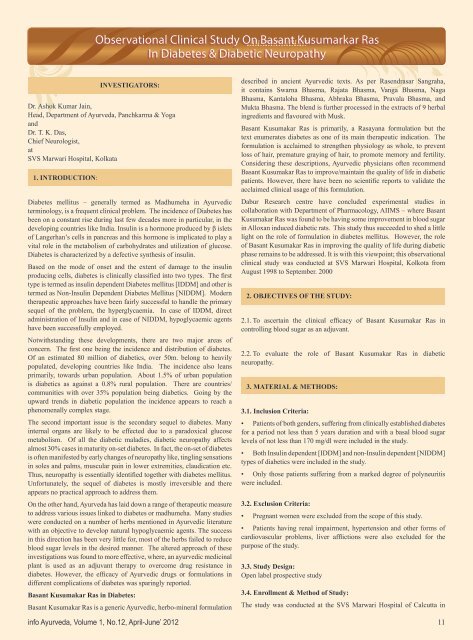

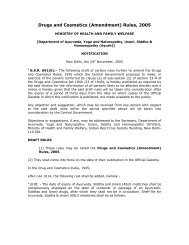
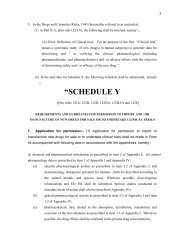
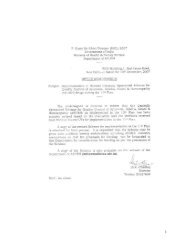

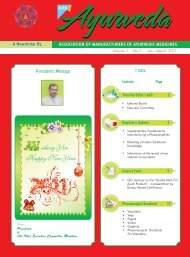

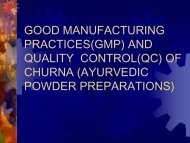
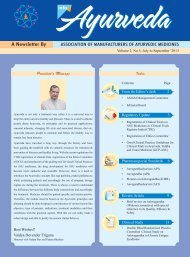
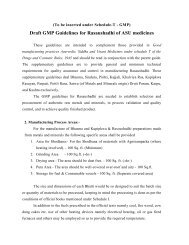
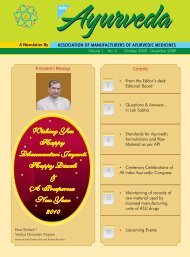
![[To be published in Gazette of India Part II Section 3, sub-section iii]](https://img.yumpu.com/28570283/1/190x245/to-be-published-in-gazette-of-india-part-ii-section-3-sub-section-iii.jpg?quality=85)

